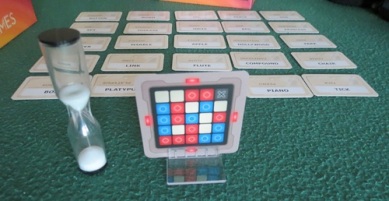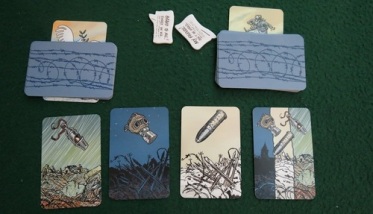In addition to the games below I also played Adventure Time Love Letter which is a version of Love Letter with art from the TV show and a few extra rules. Have you ever tried to watch Adventure Time? I tried once and thought I was having a stroke.
Codenames
Players: 7 (Plays 2-8)
Duration: 30 Minutes
Codenames is a simple word game that is getting a lot of plays in the warm-up hour at my weekly game group. The bulk of the game is a few hundred cards each with a different noun on like bug, Spain, fighter, comic etc. 25 cards are randomly chosen and put into a 5×5 grid in the centre of the table and players split into two teams (red and blue). One player from each team is picked as captain and the captains get to see a secret card which is another 5×5 grid with squares coloured red, blue or beige (and one black) which corresponds to the word grid in front of everyone. On their team’s turn Captains have to give a clue consisting of one word that matches some of the clues of their teams colour and the number of clues it matches. For example, the clue ‘Batman 4’ means that the captain is trying to tell their team that 4 cards in the grid match their colour and are related to Batman somehow. The team then tries to guess the full complement of cards. If they make a mistake they have to stop guessing otherwise they keep going until they have made as many guesses as the number in the clue. The team that gets all their words first is the winner unless a team incorrectly guesses the black card in which case they lose immediately.

This game feels like it has been around for years. Like Balderdash and Taboo I am sure I played it with my family when I was a kid but it is less than a year old. The premise is simple and doesn’t require a huge vocabulary (like Scrabble) so anybody can join in this accessible word game. Rounds can be a bit slow if someone is trying to come up with a killer clue (my group are definitely guilty of this) so I would recommend using the egg-timer that comes with it to move rounds along at a brisk pace. The added time pressure makes the game a lot more fun and increases the chance of an awful panic clue that loses a team the game – far more entertaining than a good clue that someone took 5 long minutes of silent thinking to come up with.
Codenames is a solid party game that will inspire a lot of discussion in the right group. The fun wears thin quickly but if you have 15 minutes to fill and at least 4 people then it is definitely worth a punt.
Abyss: Kraken
Players: 3 (Plays 2-4)
Duration: 90 minutes
On the surface Abyss looks like Guillermo Del Toro’s Little Mermaid remake but at its heart it’s a simple game of card collection with a bit of engine-building and auctioning thrown in for good measure. It’s a game I like and my full impressions can be found in a previous blog post but this one is about the expansion called Kraken.
Kraken introduces a few supplementary and a few new features to the game. The first are the new kraken allies that act as wild cards when buying lords. This is a pretty powerful effect as a wild colour can mean that you can get faster access to the lords that you want and so obtain special powers and points even sooner. There is a downside however in that players who take kraken are also forced to take an alternative currency called nebulises. More cash sounds nice but players can only spend them when they have run out of pearls (the regular currency from the base game) and nebulises count as negative points at game end (the player with the most nebulises also gets an additional 5 point penalty).

Bolstering this feature are new neutral lords called smugglers that help players dispose of their dirty currency as well as new lands (the next level of points after lords) that relate to those tainted nebuli. One thing that didn’t come up in our playthrough is a land that lets you plunder a new loot deck which is like a push your luck minigame that can net you a wide variety of points. The loot deck seems like a bit of a novelty but still nowhere near the sea monster part of the original game which ironically does feel like an add-on. I was hoping this would be fleshed out on an expansion but it still feels quite bare.
Due to a sub-par performance by me I am tempted to say that this expansion sucks as hard as the briney blue sea but actually this expansion is a great addition to a good game. It integrates smoothly in the main game without the need for extra boards or bolt-ons and I would easily recommend it to fans of Abyss.
The Grizzled
Players: 4 (Plays 2-5)
Duration: 30 minutes
The Grizzled is a co-op set in the despair and trenches of World War I. Players take the role of friends who join up at the start of the Great War and are trying to stay sane and alive until Armistice Day. The horrors of war are represented a deck of ‘trials’ cards which either depict threats (one or more of bullets, gas, whistle, snow, rain or night) or hard knocks (conditions which hinder the player and represent mental wounds on the soldiers. At the beginning of the game 25 trials cards are placed face down on an armistice card (the trials pile) and the rest are placed face down on a war monument card (the morale reserve). If there are no cards in players hands and the trials pile is empty at any point then players have made it to the end of the war and won but if the morale pile is empty then players have lost.

Each round (or mission) consists of four steps. The first is the Preparation where the mission leader (first player) chooses the intensity number of the mission. Players are then dealt this number of cards each from the trials pile. Then play proceeds to step 2 which is the Mission itself where players take turns to play cards from their hand either into the centre of the table (no-mans land) if it is a threat card or in front of them if it is a hard-knock card. If there are ever three of the same type of threat visible across cards in no-mans land then the players have lost the mission and those cards are shuffled back into the trials pile to be faced again. To stop this happening players can withdraw instead of playing a card which takes them out the mission and stops them from losing the mission if they have the wrong cards. If all players withdraw successfully then the mission is a success and all the cards in no-mans land are discarded from the game.
Players also have two other actions they can play. If a player has a speech token (obtained by passing the first player token at the end of the mission) they can nominate a threat type and all other players can discard one card from their hand that has that threat which is a great way of emptying players hands. The last action is to use their players good luck charm which lets them discard a card from no-mans land that matches their characters threat type. However once that good luck charm is used it can’t be used again unless regenerated.

The third step is Support. When players withdraw they secretly nominate a player to give support to. After a Mission is successful players reveal who they gave support to and if one player has received more support than every other then they get to either discard two hard-knocks in front of them or regenerate their good luck charm. If the mission was lost they only get to discard one hard-knock in front of them. Also, if a player has four hard-knocks at the end of this step then they have received too much mental damage and the players lose. Last of all is the Intensify stage where players count up the number of cards in their hands and transfer that number of cards from the morale reserve to the trials pile (to a minimum of 3) making victory further away and defeat ever closer.
I love the mechanics, theme and look of this game but it seems like it was just too easy to win. Maybe I have been beaten into submission by the gruelling Pandemic Legacy campaign I am currently playing through but I generally expect co-op games to present a real challenge. We played a 3 and a 4 player game and we were never really pushed that hard. Admittedly we didn’t play the speech rule correctly (there has been an errata rulebook published) and for the first game we played easy mode (for normal some cards have a symbol on that means you have to immediately play a card blind from the trials pile) but it didn’t feel like that would have made much of a difference. Maybe we stumbled across the winning formula or just got lucky, it’s certainly possible that we drew perfect cards but for lovers of co-op games I would be hard-pressed to recommend The Grizzled. I still like the game and would love to try it 5 player (apparently this is the most difficult player count) but overall I am a little disappointed.











